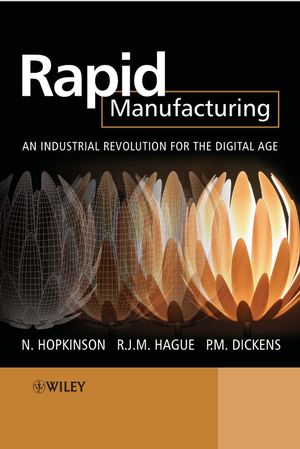Rapid Manufacturing: An Industrial Revolution for the Digital AgeISBN: 978-0-470-01613-8
Hardcover
304 pages
December 2005
 This is a Print-on-Demand title. It will be printed specifically to fill your order. Please allow an additional 10-15 days delivery time. The book is not returnable.
|
||||||
Editors.
Foreword (Terry Wohlers).
1 Introduction to Rapid Manufacturing (Neil Hopkinson, Richard Hague and Phill Dickens).
1.1 Definition of Rapid Manufacturing.
1.2 Latitude of Applications.
1.3 Design Freedom.
1.4 Economic for Volumes down to One.
1.5 Overcoming the Legacy of Rapid Prototyping.
1.6 A Disruptive Technology.
1.7 A Breakdown of the Field of Rapid Manufacturing.
2 Unlocking the Design Potential of Rapid Manufacturing (Richard Hague).
2.1 Introduction.
2.2 Potential of Rapid Manufacturing on Design.
2.3 Geometrical Freedom.
2.4 Material Combinations.
2.5 Summary.
3 Customer Input and Customisation (R.I. Campbell).
3.1 Introduction.
3.2 Why Is Customer Input Needed?
3.3 What Input can the Customer Make?
3.4 How Can Customer Input Be Captured?
3.5 Using Customer Input within the Design Process.
3.6 What Is Customisation?
3.7 Determining Which Features to Customise.
3.8 Additional Customisation Issues.
3.9 Case Study – Customising Garden Fork Handles.
3.10 Conclusions.
4 CAD and Rapid Manufacturing (Rik Knoppers and Richard Hague).
4.1 Introduction.
4.2 CAD Background.
4.3 Relations between CAD and Rapid Manufacturing.
4.4 Future Developments Serving Rapid Manufacturing.
4.5 CAD for Functionally Graded Materials (FGMs).
4.6 Conclusion.
5 Emerging Rapid Manufacturing Processes (Neil Hopkinson and Phill Dickens).
5.1 Introduction.
5.2 Liquid-Based Processes.
5.3 Powder-Based Processes.
5.4 Solid-Based Processes.
6 Materials Issues in Rapid Manufacturing (David L. Bourell).
6.1 Role of Materials in Rapid Manufacturing.
6.2 Viscous Flow.
6.3 Photopolymerization.
6.4 Sintering.
6.5 Infiltration.
6.6 Mechanical Properties of RM Parts.
6.7 Materials for RM Processes.
6.8 The Future of Materials in Rapid Manufacturing.
7 Functionally Graded Materials (Poonjolai Erasenthiran and Valter Beal).
7.1 Introduction.
7.2 Processing Technologies.
7.3 Rapid Manufacturing of FGM Parts – Laser Fusion.
7.4 Modelling and Software Issues.
7.5 Characterisation of Properties.
7.6 Deposition Systems.
7.7 Applications.
8 Materials and Process Control for Rapid Manufacture (Tim Gornet).
8.1 Introduction.
8.2 Stereolithography.
8.3 Selective Laser Sintering.
8.4 Fused Deposition Modeling.
8.5 Metal-Based Processes.
9 Production Economics of Rapid Manufacture (Neil Hopkinson).
9.1 Introduction.
9.2 Machine Costs.
9.3 Material Costs.
9.4 Labour Costs.
9.5 Comparing the Costs of Rapid Manufacture with Injection Moulding.
10 Management and Implementation of Rapid Manufacturing (Chris Tuck and Richard Hague).
10.1 Introduction.
10.2 Costs of Manufacture.
10.3 Overhead Allocation.
10.4 Business Costs.
10.5 Stock and Work in Progress.
10.6 Location and Distribution.
10.7 Supply Chain Management.
10.8 Change.
10.9 Conclusions.
11 Medical Applications (Russ Harris and Monica Savalani).
11.1 Introduction.
11.2 Pre-Surgery RM.
11.3 Orthodontics.
11.4 Drug Delivery Devices.
11.5 Limb Prosthesis.
11.6 Specific Advances in Computer Aided Design (CAD).
11.7 In Vivo Devices.
12 Rapid Manufacturing in the Hearing Industry (Martin Masters, Therese Velde and Fred McBagonluri).
12.1 The Hearing Industry.
12.2 Manual Manufacturing.
12.3 Digital Manufacturing.
12.4 Scanning.
12.5 Electronic Detailing.
12.6 Electronic Modeling.
12.7 Fabrication.
12.8 Equipment.
12.9 Selective Laser Sintering (SLS).
12.10 Stereolithography Apparatus (SLA).
12.11 Raster-Based Manufacturing.
12.12 Materials.
12.13 Conclusion.
13 Automotive Applications (Graham Tromans).
13.1 Introduction.
13.2 Formula 1.
13.3 Cooling Duct.
13.4 The ‘Flickscab’.
13.5 NASCAR.
13.6 Formula Student.
14 Rapid Manufacture in the Aeronautical Industry (Brad Fox).
14.1 Opportunity.
14.2 Overview.
14.3 Historical Perspective.
14.4 Aeronautical Requirements for RM.
14.5 Why RM Is Uniquely Suited to the Aeronautical Field.
14.6 Acceptable Technologies.
14.7 Qualifying RM Systems.
14.7.1 Qualifying SLS at British Aerospace (BAe).
14.7.2 Qualifying SLS at Northrop Grumman.
14.8 Summary.
14.9 Case Studies.
15 Aeronautical Case Studies using Rapid Manufacture (John Wooten).
15.1 Introduction.
15.2 Problem and Proposed Solution.
15.3 Benefits of a Rapid Manufacture Solution.
15.4 Pre-Production Program.
15.5 Production.
15.6 Summary.
16 Space Applications (Roger Spielman).
16.1 Introduction.
16.2 Building the Team.
16.3 Quality Assurance.
16.4 How to ‘Qualify’ a Part Created Using This Process.
16.5 Producing Hardware.
17 Additive Manufacturing Technologies for the Construction Industry (Rupert Soar).
17.1 Introduction.
17.2 The Emergence of Freeform Construction.
17.3 Freeform Construction Processes: A Matter of Scale.
17.4 Conclusions.
18 Rapid Manufacture for the Retail Industry (Janne Kyttanen).
18.1 Introduction.
18.2 Fascinating Technology with Little Consumer Knowledge.
18.3 The Need for Rapid Prototyping to Change to Rapid Manufacturing.
18.4 Rapid Manufacturing Retail Applications.
18.4.1 Lighting.
18.4.2 Three-Dimensional Textiles.
18.5 Mass Customisation.
18.5.1 Mass Customised Retail Products.
18.5.2 Future Posibilities of Mass Customised RM Products.
18.5.3 Limitations and Possibilities.
18.6 Experimentation and Future Applications.
Index.



